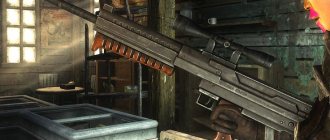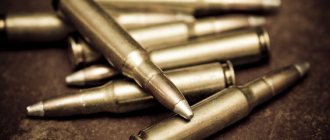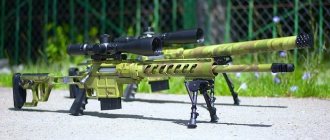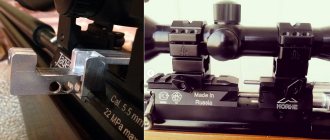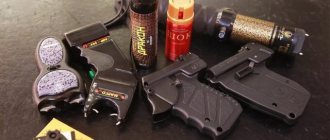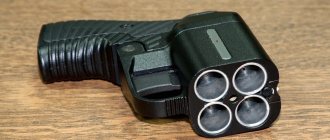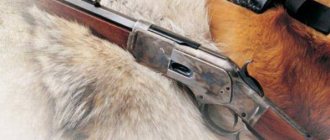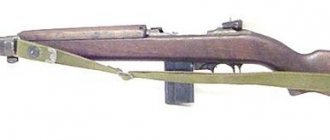The history of the creation of the OSV-96 sniper rifle
In the early 1990s, the question of the need to develop large-caliber sniper rifles arose in Russia. Similar types of sniper weapons have long existed in large European countries and the United States. To create a domestic large-caliber rifle, many design bureaus were involved throughout Russia. It should be recalled that a large-caliber rifle is considered to be one whose caliber exceeds 9 mm.
Over the course of 10 years of painstaking work, the design bureaus were able to develop a whole range of large-caliber sniper rifles of 12.7 and 14.5 mm caliber. One of the first successful models was the experimental development of the 12.7 mm B-94 caliber sniper rifle, which was developed at the Tula Instrument Design Bureau. The implementation of this project became possible thanks to the participation of A.G. Shipunov, who headed the design bureau during these years.
In 1994, a prototype of the B-94 large-caliber sniper rifle underwent a series of tests, which showed that it needed some modifications. Over the next two years, the B-94 rifle was refined at the KGP in Tula. In 1996, having successfully passed a series of factory and state tests, the B-94 sniper rifle was adopted by the Russian army.
Despite the fact that the rifle satisfied the Russian military in all respects (there was still no alternative), the Tula KGP continued work on further modernization of its large-caliber rifle. As a result of the modernizations, the B-94 sniper rifle by 2000 received the following design changes:
- The bipod of the rifle began to be mounted on a special bracket, which significantly increased the strength of the attachment;
- The bipod became adjustable in height, which made it possible to better adjust the position of the rifle;
- The sniper rifle received a different muzzle brake design, which helped reduce recoil slightly;
- The wooden butt first received a modified shape, and then it began to be made of plastic. This helped reduce the weight of the rifle. In addition, the new plastic stocks turned out to be much stronger and more reliable than wooden ones;
- The sniper rifle received new sights;
- A special handle appeared, designed for carrying a rifle.
The modernizations carried out changed the appearance of the B-94 rifle so much that it was decided to give it a new name. After a series of state tests, the updated model of the 12.7 mm sniper rifle was put into service in the spring of 2000. The new model became known as the “12.7 mm OSV-96 sniper rifle.”
Since the new OSV-96 sniper rifle was quite expensive to produce, it entered service only with the following law enforcement agencies:
- Special units of the Ministry of Internal Affairs;
- FSB;
- Special groups participating in the elimination of terrorists.
Currently widely used in the Syrian military conflict.
Design of the OSV-96 sniper rifle
The large-caliber sniper rifle is an automatic weapon. Automation operates using the energy of powder gases. Since the OSV-96 rifle has very significant dimensions, the manufacturer found an original way out of this situation. Instead of having to disassemble the rifle each time for transport, you can simply fold it. This not only eliminates unnecessary work on assembling/disassembling the weapon, but also makes the rifle always ready for battle - after all, you can put it in a combat position in a few seconds.
The new muzzle brake-compensator has significantly increased the accuracy and efficiency of shooting. The brake operates on a reactive principle, using the energy of powder gases.
The barrel channel of the OSV-96 sniper rifle is locked with a bolt. To increase reliability, it is locked with 4 lugs. This caliber requires just such a reliable locking method. To place the bipod, a special console is used, which is placed on the receiver. The bipod is height adjustable. As a result, the rifle can be installed on any uneven surface. The system for attaching the bipod to the receiver has one significant drawback - this type of attachment can negatively affect shooting accuracy, although professional snipers have long adapted to this feature of the OSV-96.
Technical characteristics of the OSV-96 rifle
TTX OSV-96 looks like this:
- The overall length of the rifle is 1,746 mm;
- With the barrel folded, it decreases to 1,154 mm;
- The barrel itself has a length of 1,000 mm;
- The ammunition used is 12.7x108 mm cartridges;
- A sniper rifle is capable of hitting targets that are located at a distance of up to 1,800 meters from it;
- In this case, shooting at targets wearing body armor or located behind small obstacles can be carried out no more than at a distance of up to 1,000 m;
- The weight of the rifle without an optical sight reaches 11.7 kg. You can only shoot from a rifle with such weight from a bipod.
In addition, it is possible to install any optical sight instead of the standard one.
Modern versions of the OSV-96 sniper rifle have only plastic stocks. They are equipped with rubber butt pads, which significantly reduce the recoil effect when firing.
Analogue
Oddly enough, our domestic rifle also has its own analogue abroad. Its name is Barrett M82. Of course, this is a popular rifle that has seen many conflicts around the globe and showed its best side in each of them. In many ways it is indeed similar to the OSV-96, in some aspects it even surpasses it, but there are a couple of aspects in which the domestic rifle wins. Like, for example, length. Yes, the “Burglar” is longer than the M82, but once it is folded, the rifle becomes shorter than its foreign competitor, while maintaining an advantage in usable barrel length. Accordingly, the OSV-96 will be somewhat more accurate, but the M82 has a faster rate of fire due to twice the magazine capacity.
Operating principle of the OSV-96 sniper rifle
The OSV-96 large-caliber sniper rifle is an automatic weapon. This means that all operations related to reloading and preparation for the next shot occur automatically due to the energy of the powder gases. This procedure proceeds as follows:
- At the moment of firing, powder gases penetrate through the gas outlet hole in the barrel into the gas tube, from where they act directly on the piston, which ejects the bolt frame;
- When the bolt carrier is thrown back, the barrel is unlocked and the spent cartridge is removed and discarded. At the same moment, the return spring is compressed, the firing pin is cocked, and the next cartridge from the magazine is sent to the dispensing line;
- Thanks to the action of the return spring, the bolt frame returns to its original position. In this case, the barrel bore is closed due to the movement of the bolt.
Despite the use of automatic weapons, the OSV-96 sniper rifle is not inferior in terms of accuracy to many models of classic bolt-action sniper rifles.
PTRS
However, it is worth starting from afar, namely from August 29, 1941. It was on this day that the Simonov self-loading anti-tank rifle entered service with the Red Army, which became in some way the progenitor of the OSV-96. It has proven itself primarily as an effective means of combating lightly armored vehicles, fortified combat points and enemy personnel hiding behind a light barrier.
Representing a massive structure just over 2 meters long and weighing 21 kilograms, the gun possessed colossal power. Largely due to its monstrous caliber, because the gun was powered by large-caliber 14.5 by 114 millimeter cartridges specially designed for penetrating tank armor. An armor-piercing bullet, that is, having a steel core inside, weighing 64 grams, flying out of a rifled barrel at a speed of 1000 meters per second, with a direct hit was capable of penetrating a sheet of steel up to 40 millimeters thick, which was enough to hit the most vulnerable points of enemy tanks.
As you can understand, with such a caliber and weight of a weapon, the shooter was exposed to colossal recoil when firing. In order to reduce its impact on the shooter, the gun was equipped with a massive muzzle brake-compensator, and the back of the butt had a shock-absorbing butt pad.
A separate plus of Simonov’s PTR is his self-reliance. When fired, part of the powder gases from the barrel was transferred through a special channel to the piston, which, in turn, moved the bolt and fired a new cartridge from a non-removable magazine with a capacity of five rounds. This is the main similarity between the PTRS and the OSV-96, since both rifles are self-loading.
And contrary to popular belief, anti-tank rifles were never equipped with sniper optical sights. An open sector-type sight served as a sighting device.
Putting a sniper rifle into combat readiness
In order to bring a sniper rifle into combat readiness mode, you need to carry out the following steps:
- First, the rifle needs to be unfolded. To do this, remove the latch, which is engaged with the trigger housing;
- Line up the barrel and receiver in one line;
- Having achieved a straight line between the barrel and the receiver, you need to connect them. To do this, you need to manipulate the locking handle. Ultimately, the handle must be fixed to a special hook on the stop;
- Next, you will need to hold the cocking handle and set the safety to the “Fire” mode. After this, you should release the moving parts of the rifle and pull the trigger. Before you pull the trigger, you must make sure that the rifle barrel is pointed in a safe direction;
- Next, you need to prepare the bipod for installing the weapon in a combat position. To do this, the bipod racks must be released from the latch that secures them;
- Prepare sights for shooting. If you plan to use an optical sight, it must be attached to the rifle. If you plan to use a mechanical sight, you should raise the rear sight housing and the post with the front sight;
- Next, you should equip the magazine with cartridges, after which the loaded magazine is attached to the rifle. Before loading cartridges into the magazine, you need to make sure that they are in a condition suitable for shooting. Cartridges that can be loaded into a magazine should not have any dents, cracks, green deposits or other defects. Do not use contaminated cartridges. They must be cleaned before use;
- Next, you should cock the moving parts of the rifle;
- After cocking, the rifle must be put on safety;
- Just before shooting begins, the safety should be set to the “Fire” position.
The rifle is now fully operational.
Design Features
As can be seen from the description and photo, the OSV-96 is not a small-sized rifle. In combat conditions, any soldier must be as mobile as possible. Therefore, the designer decided to complicate the design of the rifle and add the possibility of folding it at the junction of the rear section of the barrel and the breech. In this position, the length of the rifle is comparable to a standard SVD rifle.
Another feature that most likely not everyone noticed: the OSV-96 does not have a handguard, since it is not suitable for hand-held shooting.
Checking the accuracy and effectiveness of shooting from the OSV-96 rifle
In order for shooting from the OSV-96 rifle to be truly effective, it must be zeroed. You need to know that ammunition from different manufacturers can produce different accuracy. For zeroing, you need to take several boxes of cartridges from different manufacturers. First you need to shoot cartridges from one manufacturer, then (at another target) cartridges from another manufacturer.
You need to shoot from a bipod in a prone position. Shooting is carried out at various distances, starting from 100 meters. When shooting, you need to remember that the recoil of a large-caliber rifle, despite the presence of a rubber butt pad, will be very significant. The weapon is sighted using both an open sight and an optical or night sight.
Before using the iron sight, it must be configured. The procedure for setting up the sight is described in detail in the instructions for the weapon, which is included in the kit.
Options and modifications of the OSV-96 sniper rifle
Since the OSV-96 sniper rifle is a relatively young weapon, it has only two modifications;
- B-94 "Volga";
- OSV-96 "Burglar".
The first model, although it was adopted, was never mass-produced. It was represented by several prototypes, which were constantly being improved. There is no point in listing all the intermediate options, so the B-94 rifle, which was in service with the Russian army from 1996 to 2000, is considered to be the first and only modification that preceded the OSV-96.
A more advanced modification is the OSV-96, which is now actively used by special forces of law enforcement agencies. It received many improvements that made it not just an upgraded version of the B-94, but a new model.
PTRD
Since we already touched upon the Simonov system gun, we simply could not help but mention its direct competitor. On the same day, August 29, the second model of long-range anti-tank weapons was put into service. Its designer, Vasily Aleksandrovich Degtyarev, is most likely known to you, but as the author of the well-known machine gun, however, as it turned out, Vasily was able to make his invaluable contribution to the victory by creating an anti-tank rifle of his own design.
The PTRD was much simpler than its brother, but at the same time lighter - its weight was 17.5 kilograms in running order - and slightly shorter. Also, unlike the Simonovsky version, Degtyarev’s gun was single-shot, with a longitudinally sliding rotary bolt, which greatly simplified its production.
Countries that actively use OSV-96
Since the OSV-96 rifle is the very first domestic sniper rifle of this class, representatives of law enforcement agencies of many countries were very interested in purchasing it. Basically, it was bought by states that are part of the CIS, but it is also in service with several non-CIS countries.
The technical features of the OSV-96, which make it possible to hit targets wearing body armor at a distance of 1,000 meters, have led to high demand for these rifles in the following countries:
- Belarus - these rifles are in service with special units of the Almaz type;
- Kazakhstan purchased OSV-96 for airmobile troops and special forces;
- In Kyrgyzstan, these rifles are also used by special forces;
- The Azerbaijani Army adopted the SALT-96 into service with its army;
- India has purchased a batch of rifles for its naval special forces "MARCOS";
- The Syrian Army also has a significant amount of SALT-96 in service, as they demonstrated during the recent conflict.
As can be seen from the list, the OSV-96 large-caliber rifle is too expensive a weapon to equip regular army units with. But its purchase for special forces proves that the combat qualities of this weapon are very high.
The OSV-96 rifle is a striking example of the fact that Russia is still capable of developing the best small arms in the world.
